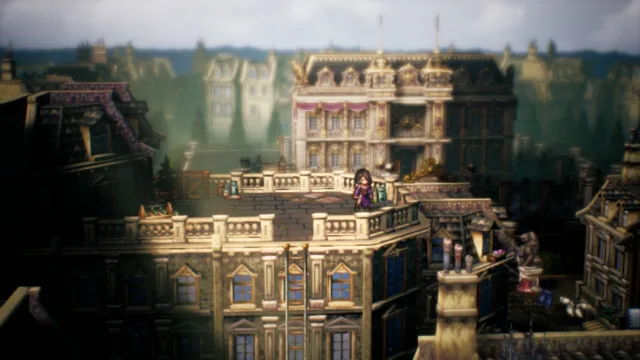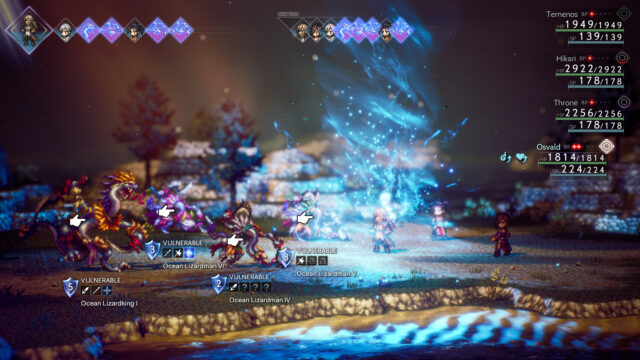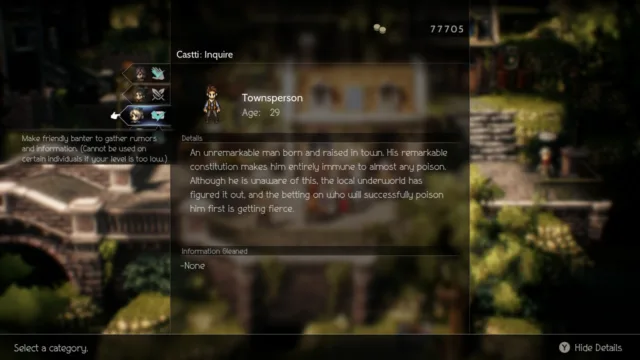Octopath Traveler II Review
Surrender Yourself Not Unto Silent Dusk
While the original Octopath Traveler spent a good eighteen months between announcement, multiple demos, and release, Acquire and Square Enix gave RPGamers a scant five months to prepare themselves for the release of its exciting sequel. Knowing what worked the first time and playing to those strengths while shoring up the areas fans noted as shortcomings in the original title, Octopath Traveler II is a shining example of what a highly-polished turn-based JPRG can offer modern players.
While the glowing elements of Octopath Traveler II are many, storytelling is definitely at the forefront. The excellence in writing hits at so many different levels that it’s hard to describe just how fulfilling it is. It’s evident in the short form through the descriptive paragraphs many NPCs are provided with. These are always fascinating reads as they contain so much history of the characters in a few hilarious, heartwarming, heartbreaking, or downright scary sentences. A more robust example is the travel banter between party members, often in small scripted events. While these disappointingly only occur between the four members in the active party, they are excellent ways to see party members interact before the final chapter, as most story chapters in Octopath treat chapter’s main character as if they were on their own. The stories told in the individual character chapters are most worthy of praise, and while they run the gamut from happy personal growth stories to ones that will make players cringe in revulsion at the depravity that evil can inflict upon the most innocent, all are excellently written. Any game would be lucky to have one of these main stories as its overarching tale, but Octopath Traveler II bountifully offers up eight for players’ enjoyment.
New to Octopath Traveler II are story chapters that don’t fall into such singular focus called Crossed Paths. They involve pairs of characters working together to solve small-scale problems in towns. The pairs chat constantly while short five-to-fifteen minute stories play out, showing the eight travelers actually acting like companions. Unlike the vague hints dropped along the way and played out in sidequests in the first entry, in Octopath Traveler II there are obvious big-picture events taking place in the land of Solistia, and they come to a head in a final chapter that becomes clearly signposted and available once the eight travelers’ stories are all complete. The characters interact quite a bit in this final chapter and in very fulfilling manners. While concerns about wildly disparate storytelling aren’t completely put to rest in this sequel, having a fulfilling overarching story with a true final chapter that wraps things up is a huge improvement over the first game. Overall, the amazing variety of scale and storytelling makes for a finely-polished narrative experience.
With such excellence in writing, players might be willing to compromise a bit on other artistic presentations in Octopath Traveler II, but there is really no need to. Both aurally and visually, the game is stunning. Five years after the original Octopath Traveler introduced players to the wonders of HD-2D, all the sprites and amazing backgrounds, foregrounds, and midgrounds are still impressive enough to not have players growing weary of this graphical style. Everything looks so alive, especially when there’s slight movement caused by wind or changing light patterns. Every character has their own job outfit and the detail of each can be seen during the wide variety of battle animations, some of which might only be seen if a single character with a certain job performs a specific skill. There is a lot of attention paid to these characters and their movements, and they look great. Even amidst all this visual splendor, the game does offer up a couple of noteworthy nitpicks. Much like the first title, monster designs rely too heavily on reskinned versions battling together at the same time, and too often, no matter how players adjust light levels in-game or via the Switch itself, the glow of the sun or light from torches wash out colors to a near bright white, most often near the center of the screen where it’s most notable.

The level of pixelated details from foreground to background is sometimes breathtaking in its scale.
The beefy soundtrack by composer Yasunori Nishiki, consisting of over 125 selections, offers no comparable caveat. All of the eight protagonists come with their own package of unique tracks that become immediately relatable to their home town or region, and the boss and battle themes are excellent bangers. Matching the excellence in musical direction, the voice acting is most definitely another strength. Voiced characters come from all over the land of Solistia, and while slight changes in accents are noticeable and welcome, thankfully they never veer into overly jarring or fall too far into tropey racial or regional stereotypes.
Matching the high bars set by the storytelling and artistic design, the battle system in Octopath Traveler II is one most turn-based fans will treasure. Building on the foundation of the first game, the battle system is one that keeps players in full control of each character with a great amount of information packed onto the battle screen. Turn order is clearly displayed at the top of the screen and moving the cursor through the menu to various attacks and skills demonstrates the resulting changes to that order before one chooses to proceed. Enemies have shields that can be broken given enough of the right hits, and once players find the correct weapon or element to hit them with, an icon of the corresponding type remains on-screen each time the enemy is encountered. Besides being a deeply gratifying moment in battles, breaking enemy shields prevents them from attacking that turn and the next and allows for an increase in damage dealt while enemies are stunned. While half of the Octopath battle system revolves around breaking the enemies’ shields, the other half involves boosting one’s own characters. Boost points (BP) are awarded to characters every turn. Players can bank a maximum of five of these, using up to three on any given character’s turn to boost attack, skill, or spell power, with some of the highest-power skills and spells requiring full BP expenditure.
Every character is locked into a set job at the beginning of the game, but can subclass in another and has full access to both pools of learned job skills during battle. Job Points (JP) are earned each battle along with money and experience points; these JP can be spent to purchase the eight battle skills unique to each job, which in turn unlock passive support skills that grant passive buffs such as increased stats, rewards after battle, or various immunities and other powers. All of these allow for players to enjoyably customize characters with enough detail to cater to individual play styles. Small but powerful additions to the battle system this time are the latent powers. Each latent power is unique to each character and based on their starting class. These powers are controlled by a meter that fills during battle when giving or receiving damage, and when full, unleashes powerful attacks or grants immense buffs. They can be decisive battle-changers when unleashed at just the right time. Already built upon the excellent battle system of the first game, the small pieces it adds raise the bar even higher.

There is always a lot of beautiful action taking place in each battle, but too often reskins fight alongside each other.
The chapter system that is employed in the game clearly shows where players need to go to start the next portion of each character’s story on the world map, along with a suggested party level. In a welcome adjustment from the first game, not all second and third chapters have the same suggested level. Instead they are staggered in such a way to guide those less experienced players on smoother path that can avoid required periods of needed heavy grinding in order to advance the story. However, the levels can give a bit of false hope as there are many bosses in chapters that can prove challenging roadblocks even to parties averaging five to ten levels over what is suggested, all dependent on party and skill setup. Similarly, for those that delve deep and find their own game-breaking setups, under-leveled parties can find a great deal of success. While some might occasionally feel the stress of the difficulty, the endorphin rush experienced by personally discovering a skillful mix of characters and classes is tough to replicate.
When taking a break from battling or advancing the story, Octopath Traveler II offers up more enjoyable systems for players to engage in. Each playable character has a pair of path actions they can perform on most NPCs. These actions are determined by the time of day, something easily toggled between at the touch of a button, and include various ways of learning about NPCs, acquiring any goods they may be carrying, knocking them out, or recruiting them temporarily into the party. Sidequests in this title are not the dull “find X item” or “fight Y monsters” variety many RPGamers have come to anticipate. The vast majority can be initiated by talking to a single NPC, but need further knowledge obtained by traveling and using characters’ path actions all over the world to be completed. Players can also hunt down shrines that may be tucked away in hard-to-see places or occasionally right there in plain sight to earn their characters’ ultimate job skills, secret job classes, and even opportunities to earn extra licenses so that more than one character can subclass to the same job. Some of the jobs require tasks to be done to earn their licenses or expand their skillset. The most fulfilling optional tasks even link together job requirements and sidequests, seamlessly utilizing multiple gameplay actions to complete a single interwoven mission. These types of interactions are amazing additional world-building opportunities.
An amazing array of excellent features carried over from the first title, as well as multiple improvements both asked for by fans and added by the creative team at Acquire, lead Octopath Traveler II to be one of the most enjoyable lengthy titles I’ve played in years. Even during some small moments of grinding needed during my 70+ hours, the battle system, sidequests, and character customization always kept me fully engaged in the story and what I was experiencing. There’s little doubt that turn-based RPG fans will find incredible satisfaction from the title, and those who enjoy expansive lore and deep, customizable job systems will fall head-over-heels in love.
Disclosure: This review is based on a free copy of the game provided by the publisher.


A wide variety of music from pleasantly atmospheric to bombastic bangers
Amazing writing and storytelling, from the grandiose to most granular
Beautifully detailed HD-2D graphics
Deeply customizable and highly enjoyable combat system
Graphics wash out occasionally
Too many reskinned enemies fighting together in the same battle






Recent Comments